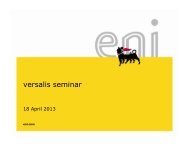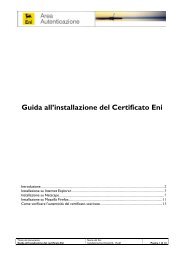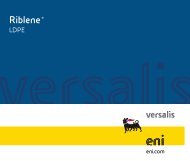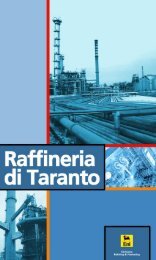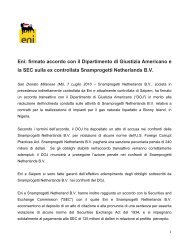È in corso il restauro conservativo del Duomo di Milano. Un ... - Eni
È in corso il restauro conservativo del Duomo di Milano. Un ... - Eni
È in corso il restauro conservativo del Duomo di Milano. Un ... - Eni
You also want an ePaper? Increase the reach of your titles
YUMPU automatically turns print PDFs into web optimized ePapers that Google loves.
SCENARI - SCENARIOS<br />
Tecniche d’<strong>in</strong>novazione <strong>di</strong> RENZO MAZZEI<br />
Nel primo volume <strong>del</strong>l’Enciclope<strong>di</strong>a degli Idrocarburi sono<br />
trattate le varie tessere <strong>di</strong> un mosaico che descrive le attività<br />
<strong>di</strong> esplorazione, produzione e trasporto degli idrocarburi<br />
secondo un’impostazione logica <strong>di</strong> sequenzialità e organicità.<br />
Il volume si apre con una parte <strong>in</strong>troduttiva che riporta alcuni cenni<br />
storici sull’<strong>in</strong>dustria petrolifera, sull’evoluzione <strong>del</strong>la geologia <strong>del</strong> petrolio,<br />
sui cicli <strong>di</strong> ricerca e scoperta, sulle riserve mon<strong>di</strong>ali e sui bac<strong>in</strong>i<br />
petroliferi.<br />
Successivamente gli argomenti vengono raggruppati <strong>in</strong> sette gran<strong>di</strong><br />
aree <strong>di</strong> attività: geoscienze, esplorazione petrolifera, perforazione e<br />
completamento pozzi, caratteristiche dei giacimenti e relativi stu<strong>di</strong>,<br />
sv<strong>il</strong>uppo dei giacimenti petroliferi, produzione, trasporto idrocarburi e<br />
stoccaggio gas.<br />
In questo primo volume sono affrontati tutti gli argomenti<br />
<strong>in</strong>erenti l’attività <strong>di</strong> upstream, ma tra questi riteniamo opportuno<br />
segnalarne alcuni che risultano particolarmente r<strong>il</strong>evanti<br />
per <strong>il</strong> significativo grado <strong>di</strong> avanzamento tecnologico<br />
o perché mostrano <strong>in</strong>novativi approcci rispetto al passato.<br />
Per quanto riguarda la genesi degli idrocarburi, ad esempio,<br />
è ut<strong>il</strong>e segnalare la chiara posizione espressa nel volume<br />
sull’orig<strong>in</strong>e organica <strong>del</strong> petrolio e sui fenomeni collegati alla<br />
naftogenesi. In questo modo si <strong>in</strong>tende superare <strong>il</strong> lungo e<br />
ricorrente <strong>di</strong>battito animato dalle varie teorie e ipotesi formulate<br />
negli anni a supporto <strong>del</strong>l’orig<strong>in</strong>e <strong>in</strong>organica <strong>del</strong> petrolio.<br />
Legate al tema <strong>del</strong>la formazione degli idrocarburi, <strong>in</strong>teressanti<br />
le parti sui fenomeni <strong>di</strong> migrazione e accumulo <strong>di</strong><br />
olio e gas, la descrizione <strong>del</strong>le rocce madri, <strong>di</strong> copertura e<br />
serbatoio e la casistica relativa ai vari tipi <strong>di</strong> trappole.<br />
Tra i meto<strong>di</strong> <strong>di</strong> ricerca petrolifera, sono <strong>di</strong> particolare importanza<br />
<strong>il</strong> teler<strong>il</strong>evamento, i sistemi cartografici <strong>di</strong>gitali<br />
e, fra i meto<strong>di</strong> <strong>di</strong> ricerca <strong>in</strong><strong>di</strong>retta, le prospezioni geofisiche<br />
che comprendono i r<strong>il</strong>evamenti sismici a riflessione,<br />
sia 2D che 3D, e i relativi sistemi <strong>di</strong> registrazione ed elaborazione<br />
dati. Negli ultimi anni i progressi <strong>del</strong>le tecniche<br />
<strong>in</strong>formatiche e <strong>del</strong>le capacità <strong>di</strong> calcolo hanno portato<br />
all’ut<strong>il</strong>izzo <strong>di</strong> sistemi <strong>di</strong> elaborazione sempre più sofisticati<br />
e complessi che permettono oggi <strong>di</strong> ottenere <strong>in</strong>formazioni<br />
sui giacimenti impensab<strong>il</strong>i solo f<strong>in</strong>o a poco tempo<br />
fa. Il giacimento viene stu<strong>di</strong>ato nelle sue caratteristiche<br />
statiche, ma anche nei suoi meccanismi d<strong>in</strong>amici<br />
tramite mo<strong>del</strong>li matematici che permettono <strong>di</strong> prevedere i suoi comportamenti<br />
futuri. I mo<strong>del</strong>li matematici così elaborati permettono<br />
<strong>in</strong>oltre <strong>di</strong> <strong>in</strong>vestigare vari schemi <strong>di</strong> sv<strong>il</strong>uppo per poter poi scegliere<br />
quello economicamente più attraente e nello stesso tempo operativamente<br />
più semplice.<br />
Anche <strong>il</strong> settore <strong>del</strong>la perforazione ha registrato negli ultimi anni notevoli<br />
progressi tecnologici. Si pensi alla perforazione <strong>di</strong>rezionata, che<br />
consente <strong>il</strong> raggiungimento <strong>di</strong> obiettivi m<strong>in</strong>erari profon<strong>di</strong> posti anche a<br />
notevole <strong>di</strong>stanza rispetto al posizionamento <strong>del</strong>l’impianto <strong>di</strong> superficie.<br />
Questa tecnica trova applicazione <strong>in</strong> numerose situazioni operative:<br />
permette <strong>di</strong> perforare più pozzi da un’unica postazione, <strong>di</strong> raggiungere<br />
obiettivi <strong>in</strong>accessib<strong>il</strong>i (zone montuose, aree e<strong>di</strong>ficate), <strong>di</strong> raggiungere<br />
obiettivi posti sotto formazioni problematiche da perforare, <strong>di</strong> ottenere<br />
più alte produzioni perforando <strong>in</strong> orizzontale aree <strong>di</strong> giacimento<br />
a bassa produttività.<br />
Nel campo <strong>del</strong>la perforazione <strong>in</strong> mare, la nuova frontiera è rappresentata<br />
dallo sv<strong>il</strong>uppo dei giacimenti <strong>in</strong> acque ultra profonde, ambito che<br />
si pensa possa rappresentare un probab<strong>il</strong>e futuro “eldorado”. Perforare<br />
giacimenti <strong>in</strong> fondali mar<strong>in</strong>i superiori ai 1.500 metri è un’impresa<br />
estremamente complessa <strong>in</strong> cui vengono amplificate le già <strong>in</strong>genti <strong>di</strong>fficoltà<br />
<strong>di</strong> perforazione <strong>in</strong> acque profonde, cioè <strong>in</strong> fondali che vanno<br />
dai 450 ai 1.500 metri.<br />
54<br />
<strong>Un</strong> sottocapitolo <strong>del</strong>lo sv<strong>il</strong>uppo dei giacimenti <strong>in</strong> mare è de<strong>di</strong>cato alle<br />
tecniche <strong>di</strong> sv<strong>il</strong>uppo dei campi marg<strong>in</strong>ali, cioè <strong>di</strong> piccoli giacimenti<br />
geograficamente <strong>di</strong>spersi, <strong>il</strong> cui sfruttamento non sarebbe economicamente<br />
vantaggioso se non venissero adottati alcuni particolari accorgimenti<br />
resisi <strong>di</strong>sponib<strong>il</strong>i negli anni recenti.<br />
Il volume affronta poi <strong>in</strong> modo estremamente attuale <strong>il</strong> tema <strong>del</strong>la gestione<br />
<strong>di</strong> un giacimento durante la fase <strong>di</strong> produzione. Vengono <strong>in</strong><strong>di</strong>cati<br />
allora i sistemi <strong>di</strong> monitoraggio, i possib<strong>il</strong>i <strong>in</strong>terventi da effettuare<br />
durante la vita produttiva <strong>di</strong> un giacimento (<strong>in</strong>terventi <strong>in</strong><strong>di</strong>viduati attraverso<br />
<strong>il</strong> costante aggiornamento dei mo<strong>del</strong>li matematici precedentemente<br />
costruiti), le necessità <strong>di</strong> eventuali ulteriori <strong>in</strong>vestimenti. Tra le<br />
tecniche adottate per l’ottimizzazione <strong>del</strong>la produzione si trovano i sistemi<br />
<strong>di</strong> sollevamento artificiale dei pozzi a olio, le tecniche <strong>di</strong> frattu-<br />
razione <strong>del</strong>la roccia per l’aumento <strong>del</strong>la produttività dei pozzi, i sistemi<br />
<strong>di</strong> <strong>in</strong>ibizione <strong>del</strong>la produzione <strong>di</strong> acqua e gas nei pozzi ad olio, etc.<br />
A conclusione <strong>del</strong>la parte sulla produzione, un breve ma <strong>in</strong>teressante<br />
capitolo sulle varie azioni, economicamente compatib<strong>il</strong>i, adottate per<br />
prolungare la vita <strong>del</strong> giacimento e sui motivi, <strong>in</strong>vece, che <strong>in</strong>ducono all’abbandono<br />
<strong>di</strong> un giacimento, siano essi <strong>di</strong> carattere tecnico, economico,<br />
politico o strategico.<br />
In chiusura <strong>di</strong> volume viene affrontato <strong>il</strong> tema <strong>del</strong> trasporto e <strong>del</strong>lo<br />
stoccaggio degli idrocarburi. Di particolare r<strong>il</strong>evanza la parte relativa<br />
al trasporto <strong>del</strong> gas, sia con tecnologie <strong>di</strong> liquefazione (LNG) che <strong>di</strong><br />
compressione (CNG), e al suo stoccaggio. Quest’ultimo argomento,<br />
riferito all’immagazz<strong>in</strong>amento <strong>in</strong> sotterraneo, cioè <strong>in</strong> serbatoi naturali,<br />
<strong>del</strong> gas importato <strong>in</strong> eccesso nel periodo <strong>di</strong> m<strong>in</strong>or consumo, è oggi <strong>di</strong><br />
grande attualità per <strong>il</strong> ruolo determ<strong>in</strong>ante nello sv<strong>il</strong>uppo <strong>del</strong> mercato<br />
<strong>del</strong> gas e nella sua stab<strong>il</strong>izzazione.<br />
Non va <strong>in</strong>oltre <strong>di</strong>menticato <strong>il</strong> ruolo fondamentale assunto dallo stoccaggio,<br />
oltre che per la regolazione stagionale, per <strong>il</strong> mantenimento<br />
<strong>del</strong>le riserve strategiche <strong>in</strong> grado <strong>di</strong> garantire la fornitura ai mercati<br />
anche <strong>in</strong> caso <strong>di</strong> riduzione degli approvvigionamenti.<br />
Renzo Mazzei, geologo e collaboratore <strong>del</strong>la Scuola Enrico Mattei, ha lavorato<br />
a lungo <strong>in</strong> <strong>Eni</strong> nel settore upstream.<br />
<strong>Eni</strong>’s Way<br />
The <strong>in</strong>novation factor by RENZO MAZZEI<br />
The first volume of the Encyclopae<strong>di</strong>a of Hydrocarbons<br />
deals with the pieces of the puzzle that describes<br />
exploration, production and transport of hydrocarbons,<br />
follow<strong>in</strong>g a logic, ordered and organic structure.<br />
The volume beg<strong>in</strong>s with an <strong>in</strong>troduction that features some<br />
historic annotations on the o<strong>il</strong> <strong>in</strong>dustry, on the evolution of<br />
petroleum geology, on research and <strong>di</strong>scovery cycles, on world<br />
reserves and on o<strong>il</strong> bas<strong>in</strong>s.<br />
Thereafter, topics are grouped <strong>in</strong> 7 broad activity areas:<br />
geosciences, petroleum exploration, dr<strong>il</strong>l<strong>in</strong>g and completion of<br />
wells, o<strong>il</strong> field characteristics and relevant stu<strong>di</strong>es,<br />
development of hydrocarbon fields, production, hydrocarbon<br />
transport and gas storage.<br />
This first volume<br />
tackles all topics<br />
regard<strong>in</strong>g upstream<br />
activities, yet we<br />
reckon it is<br />
worthwh<strong>il</strong>e po<strong>in</strong>t<strong>in</strong>g<br />
out some<br />
particularly<br />
relevant ones,<br />
consider<strong>in</strong>g the<br />
significant<br />
technological<br />
progress achieved<br />
or because they<br />
present <strong>in</strong>novative<br />
approaches.<br />
As to the genesis<br />
of hydrocarbons,<br />
for example, the<br />
position expressed<br />
<strong>in</strong> the volume on<br />
the organic orig<strong>in</strong><br />
of petroleum and<br />
the phenomena<br />
l<strong>in</strong>ked to it is<br />
particularly clear. In<br />
this way we hope<br />
LE ORIGINI. A s<strong>in</strong>istra, una roccia-madre<br />
contenente alcune gocce <strong>di</strong> petrolio.<br />
Si tratta <strong>di</strong> rocce se<strong>di</strong>mentarie come arg<strong>il</strong>le,<br />
calcari e dolomie che contengono<br />
una sostanza organica <strong>in</strong> concentrazione<br />
sufficiente a generare petrolio.<br />
A destra, alcuni foss<strong>il</strong>i rappresentati<br />
da resti <strong>di</strong> organismi plantonici.<br />
ORIGINS. Left, a source rock hold<strong>in</strong>g<br />
a few drops of o<strong>il</strong>. These are se<strong>di</strong>mentary<br />
rocks such as clay, limestone and dolomite<br />
hav<strong>in</strong>g an organic substance concentrated<br />
to a degree enough to generate petroleum.<br />
Right, a few foss<strong>il</strong>s consist<strong>in</strong>g of rema<strong>in</strong>s<br />
of planktonic organisms.<br />
<strong>Eni</strong>’s Way<br />
to help overcome<br />
the long and<br />
recurr<strong>in</strong>g debate<br />
fed by the various<br />
theories and<br />
hypotheses<br />
expressed over<br />
time to back up the<br />
idea of an<br />
<strong>in</strong>organic orig<strong>in</strong> for<br />
o<strong>il</strong>. In connection<br />
with the subject of<br />
the formation of<br />
hydrocarbons,<br />
<strong>in</strong>terest<strong>in</strong>g sections<br />
deal with the migration and accumulation of o<strong>il</strong> and gas, the<br />
description of source rocks, cap rocks and reservoir rocks and<br />
the various types of traps.<br />
Particularly relevant among o<strong>il</strong> research methods are<br />
telesurvey<strong>in</strong>g and <strong>di</strong>gital cartography systems and, among<br />
<strong>in</strong><strong>di</strong>rect research methods, geophysical prospect<strong>in</strong>g that<br />
<strong>in</strong>clude seismic reflection techniques – both 2D and 3D – and<br />
the perta<strong>in</strong><strong>in</strong>g record<strong>in</strong>g and data-process<strong>in</strong>g systems. Over<br />
the past few years, advances made by IT techniques and their<br />
calculation capacity, led to the use of <strong>in</strong>creas<strong>in</strong>gly<br />
sophisticated and complex process<strong>in</strong>g systems, that make it<br />
possible now to get <strong>in</strong>formation on o<strong>il</strong> fields that was<br />
unconceivable only a few years back. Research may focus on<br />
the o<strong>il</strong> field’s static properties, but also on its dynamic<br />
mechanisms, by means of mathematical mo<strong>del</strong>s that allow to<br />
pre<strong>di</strong>ct its future behaviour. Mathematical mo<strong>del</strong>s of this k<strong>in</strong>d<br />
also enable to research <strong>di</strong>fferent development schemes, so<br />
as to select the most cost-effective one and at the same time<br />
most simple to run.<br />
Also the dr<strong>il</strong>l<strong>in</strong>g sector made considerable technological<br />
progress over the past years. Consider <strong>di</strong>rectional dr<strong>il</strong>l<strong>in</strong>g,<br />
which allows to reach deep m<strong>in</strong>eral objectives located also at<br />
a considerable <strong>di</strong>stance from where the topside equipment<br />
stands. The technique is implemented <strong>in</strong> several operat<strong>in</strong>g<br />
situations: it make it possible to bore several wells from one<br />
location, to reach <strong>in</strong>accessible objectives (mounta<strong>in</strong> areas,<br />
bu<strong>il</strong>t-up areas), to reach objectives located under formations<br />
that are <strong>di</strong>fficult to dr<strong>il</strong>l, to achieve greater yields by dr<strong>il</strong>l<strong>in</strong>g<br />
horizontally low-productivity fields.<br />
As to offshore dr<strong>il</strong>l<strong>in</strong>g, the new frontier is represented by the<br />
development of fields <strong>in</strong> very deep water, a sphere which<br />
hopefully might be a future ‘El Dorado’. Offshore dr<strong>il</strong>l<strong>in</strong>g where<br />
the sea depth exceeds 1,500 metres is an extremely<br />
complicated task, where the considerable problems of deepsea<br />
dr<strong>il</strong>l<strong>in</strong>g (450 to 1,500 metres) are actually amplified.<br />
A subchapter of offshore o<strong>il</strong> field development is de<strong>di</strong>cated to<br />
development techniques of marg<strong>in</strong>al fields, namely small o<strong>il</strong><br />
fields scattered around geographically, whose exploitation would<br />
not be economically viable unless some specific expe<strong>di</strong>ents,<br />
which have become ava<strong>il</strong>able only <strong>in</strong> recent years, are used.<br />
The volume then takes up <strong>in</strong> a very modern way the subject of<br />
how to manage a field dur<strong>in</strong>g the production phase. It dwells<br />
on monitor<strong>in</strong>g systems, what actions can be taken dur<strong>in</strong>g a<br />
field lifetime (actions def<strong>in</strong>ed by cont<strong>in</strong>ually updat<strong>in</strong>g the<br />
mathematical mo<strong>del</strong>s previously constructed) and the need for<br />
further <strong>in</strong>vestments. The techniques adopted to optimise<br />
production <strong>in</strong>clude artificial lift systems for o<strong>il</strong> wells, rockfractur<strong>in</strong>g<br />
techniques to <strong>in</strong>crease the well flow rate, treatments<br />
to shut off the production of water and gas <strong>in</strong> o<strong>il</strong> wells, etc.<br />
At the end of the section on production, there is then a brief<br />
but <strong>in</strong>terest<strong>in</strong>g chapter on the various economically compatible<br />
actions that can be taken to prolong the life of a field and,<br />
alternatively, on the reasons which lead to abandon<strong>in</strong>g a field,<br />
whether they be technical, economic, political or strategic.<br />
In the f<strong>in</strong>al chapter of the encyclopae<strong>di</strong>a, the topic of<br />
transportation, and storage of hydrocarbons is <strong>di</strong>scussed. Of<br />
particular relevance is the section on natural gas transport,<br />
both through liquefaction (LNG) and compression (CNG)<br />
technologies, and on its storage. This last subject, which<br />
refers to underground storage <strong>in</strong> natural reservoir of the gas<br />
imported <strong>in</strong> excess at the time of lower consumption, is today<br />
quite relevant for its crucial role <strong>in</strong> the development of the gas<br />
market and its stab<strong>il</strong>isation.<br />
Furthermore, let’s not forget the fundamental role played by<br />
stored gas not only for seasonal modulation but also for bu<strong>il</strong>d<strong>in</strong>g<br />
strategic reserves capable of meet<strong>in</strong>g market needs also<br />
<strong>in</strong> the case of supply <strong>di</strong>sruptions.<br />
Renzo Mazzei, geologist and collaborator with the Enrico Mattei School,<br />
worked a long time with <strong>Eni</strong> <strong>in</strong> the upstream sector.<br />
55



